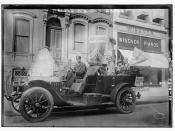Dan Brown's The Da Vinci Code, a fictional novel, was written in a factual manner. Brown took a controversial topic and created a written work of art. He used real organizations, real places, and even some real names. He also created fictional characters and places, but made no attempt to allow them to appear as such. Although the evidence used in this book was misconstrued, it played a key role in diverting the reader's attention away from his own thoughts and onto those of the author. Many Christians questioned their beliefs as they read; the faithful came out stronger than ever.
Brown took two strangers, brought them together and created the best mystery novel ever written. Robert Langdon, Harvard symbologist, and Sophie Neveu, an agent from DCPJ's cryptology department, were introduced by Sophie's murdered grandfather, Jacques Sauniere, through a code left for both of them to decipher. The fact that Jacques was killed in his own art gallery, and, in his death, left a message uniting two people, created intrigue.
The dynamic duo stuck together throughout the entire novel, breaking code after code in the hope of unraveling the mystery behind the message. Eventually needing some assistance, they made their way to Sir Leigh Teabing's home, a friend of Langdon. Oddly enough, this was the one man from whom they should have stayed the farthest. Unfortunately, they realized this only after confronted by him in the depths of Westminster Abby. "Sir Leigh Teabing felt rueful as he gazed out over the barrel of his Medusa revolver at Robert Langdon and Sophie Neveu. 'My friends,' he said, 'since the moment you walked into my home last night, I have done everything in my power to keep you out of harm's way. But your persistence has now put me in...
![[Portrait of Juan Tizol(?) and Lawrence Brown(?), Aquarium, New York, N.Y., ca. Nov. 1946] (LOC)](https://s.writework.com/uploads/7/77189/portrait-juan-tizol-and-lawrence-brown-aquarium-new-york-n-thumb.jpg)


Jesus Christ!
Some `deep` knowledge u presented here;) I personally enjoyed reading ur essay, as well as D.Brown's Book. A bit of a shame, that he is being accused of plagarism of the `Holy Grail ;(`
2 out of 3 people found this comment useful.